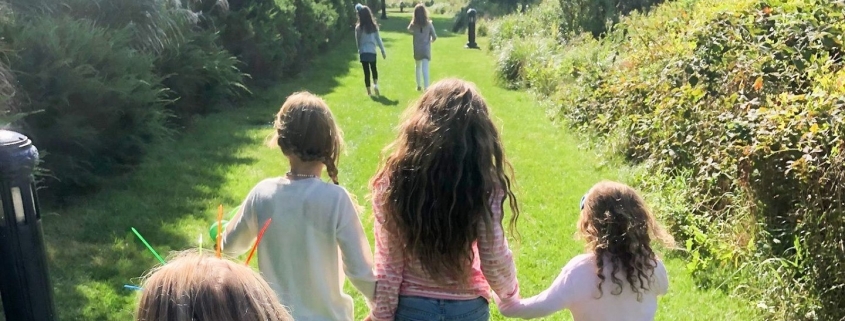4 More Ways to Encourage Resilience in Children
The Pandemic has given us a jumpstart in teaching our children about resilience, but making grit and flexibility an intentional part of our daily parenting is a gift that keeps giving over the course of a lifetime. The ability to deal with everything from minor setbacks to monumental challenges is a skill we all can improve with practice.
In Part I, we explored how to build resilience through dream boards, storytelling, play, and hobbies. In this round, we share ways to formulate confidence-building dialogue, slice problems up like a pie, allow your child to experience personal challenges, and use nature as a teaching tool for resilience.
Learn Through Dialogue and Self-talk
Children often fall into negative thought patterns, which we can help them change with the right support and repetition. For instance:
- Be realistic. Rather than saying the first day of school will be great and your child will make tons of friends, try something like: “The first day might be a bit scary, but once you settle in, you’re likely to love the routine and the friendships.”
- Listen and validate. Never brush heavy feelings off, no matter how silly or unrealistic they seem. Even though your instinct may be to immediately refute your child’s negativity, try to name what they’re feeling. Express your understanding and empathy by saying something like, “Wow, that sounds challenging. I think that would be challenging for me, too.”
- Ask questions. Probing deeper can help you find out what’s causing your child to think negatively. Often, it’s not the surface level problem, but an underlying need that has not been addressed. Asking “What happened here?” can help your child walk through the escalation, so you can dial back again. You might also ask a struggling child, “What’s the hard part?” or “How can we break this down to make it easier?” These simple prompts encourage your child to switch from emotions of frustration or discouragement to a rational, problem-solving mindset.
- Correct the record. When you run up against challenges, model positive self-talk. You might yell in frustration, “I’m a terrible cook!” and correct yourself by saying, “Actually, I’m a pretty good cook most of the time. I just messed up, but I’m not going to give up!” This shows your child even adults make mistakes and do not always think positively at first. Similarly, if you catch your child complaining, “I can’t do it!” Correct them by saying, “You can’t do it yet, you mean.”
- Broaden the perspective. Remind your child one bad apple (or experience) doesn’t ruin the bunch (or mean your child is a failure!) If your child says something like “I’m dumb!” Education Leader Bob Cunningham recommends saying something like, “I’m sorry you’re having a hard time. I know it’s frustrating, but that doesn’t mean you’re dumb.” If your child persists, you might say, “It makes me sad when you say that, because I know it isn’t true. You’re great at basketball, math, and dancing — so tell me why you feel this way.”
- Encourage. Help your child reframe by reminding that “Mistakes are proof we are trying,” and by noting, “It looks like you’re working very hard on that.” Let your child know you have faith they’ll get it with time, practice, and patience. Show your support by offering, “Go as far as you can and we’ll do it together when you get stuck.”
- Take a break. There’s no shame in taking a break. Teachers often use “calm down corners” to give kids a moment away from a frustrating task, allowing them to regroup and return to the activity at their own pace. You might say, “I can see you are feeling very upset. Let’s take a moment to do something else and come back to it when we feel ready to try again.”
- Slice up problems like a pie.
Teaching children to be aware of their thoughts and rely on optimism can be a helpful exercise. Fifth grade teacher Amy Lyon created curriculum for her students based on the “grit pie” activity in The Optimistic Child by Martin Seligman.
The “pie” represents an obstacle the child is facing. Each slice of the pie is a potential cause of the problem. Psychologists found that children were more likely to reach a positive outcome when they considered multiple sources of the problem. Students then discuss whether each slice is permanent or temporary in nature, and assess whether they blame themselves or others.
Ideally, most problems will be viewed as temporary, they’ll take some responsibility for the cause, and they’ll see the situation as within their control to change. This activity is designed to show your child how problem-solving and perseverance can resolve challenges in life.
While this exercise works best with elementary-age children, you can set the stage with toddlers by helping them recognize and name their emotions. Connecting with anger, fear, or sadness is the first step for kids toward developing strategies for calming down, clearing their heads, regulating their emotions, and brainstorming responses to triggering events.
Learn Through Personal Challenges
“Let your children fail” is a popular parenting trope that feels easier said than done. Supportive, but not overbearing is the goal, but it can be easier to practice in a situation that isn’t acutely stressful. An example of this could be choosing to give up something for a month – YouTube videos, complaining, or junk food, for example. The family can chart their progress, celebrate small victories, and appreciate the struggle together.
UPenn Psychologist Angela Duckworth has implemented the “Hard Thing Rule” at her house, which asks each member of the family to do something hard – something that requires practice, feedback, and trying again and again before getting better. Everyone chooses their own challenge, but must finish what they start, whether it’s a season of a sport or a session of music lessons.
The “Hard Thing Rule” is so effective because it combines passion (in choosing what to pursue) with perseverance (a promise to stick with it). Kids can build confidence and experience the benefits of their grit and determination.
Use Nature as a Teacher
Nature is a great teacher in resilience. Certified Parent Educator Chelsea Lee Smith tried a powerful exercise involving nature with her son that you can use too.
On a nature walk, ask your child to find a small plant or sapling. If you were to ask your child what would happen by grabbing the plant, the child would probably imagine the plant would die. “What if there was a BIG storm?” you could ask next. Surely, the plant would die then!
Next, find a tree. Of course, we cannot uproot a tree so easily. “Could the tree withstand a storm?” Certainly. If your child could choose which to be in a storm, would it be a sapling or a tree? Most kids would agree it’s better to be a “stronger” tree.
Wrap up your metaphor by explaining that people are like plants and trees, and we can actually choose how strong we grow. We will all have sun (love and household rules) and rain (challenges and things other people do we can’t control) in our lives, but we can choose to soak up the sun and let a little rain help us grow our roots deep into the soil. If we only have love without challenges, we will shrivel up in the extreme heat. If we only have rain without the sun, we will get washed away. A good balance of sun and rain provides the right support we need to learn and grow stronger. Like a tree, we can be resilient, too.
Simply getting outdoors and observing what you see, soaking up the good in each moment, is a wonderful mindfulness activity that paves the way toward resilience. In order to weather the storm, we have to find the beauty and benefit in our circumstances. We need to take a moment to find inner serenity and quiet obtrusive thoughts, to be happy for what’s right in front of us.
Let’s Grow Resilient Together!
If you’re looking for your next challenge, why not try one of the classes at the brand-new Shine Studio? We have art, music, second language, dance, and other curriculum to help children from six months to 12 years grow in resilience, while building confidence, creativity, and character.



